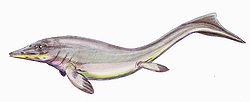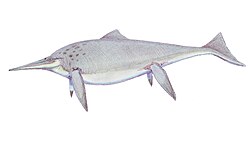| Platypterygiines Temporal range: Kimmeridgian-Cenomanian, | |
|---|---|
 | |
| Caypullisaurus bonapartei | |
| Scientific classification | |
| Kingdom: | Animalia |
| Phylum: | Chordata |
| Class: | Reptilia |
| Superorder: | † Ichthyopterygia |
| Order: | † Ichthyosauria |
| Family: | † Ophthalmosauridae |
| Subfamily: | † Platypterygiinae Arkhangelsky, 2001 |
| Genera | |
Platypterygiinae is an extinct subfamily of ophthalmosaurid thunnosaur ichthyosaurs from the early Late Jurassic to the early Late Cretaceous (Kimmeridgian - Cenomanian) of Asia, Australia, Europe, North America and South America. Currently, the oldest known platypterygiine is Brachypterygius . Platypterygiines were characterized by square tooth roots in cross-section, an extremely reduced extracondylar area of the basioccipital, prominent dorsal and ventral trochanters on humerus and ischiopubis lacking an obturator foramen. [2]







